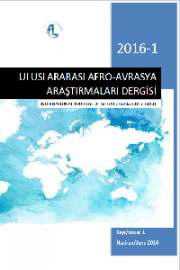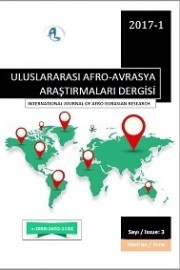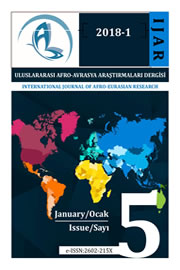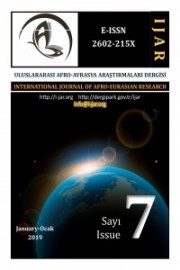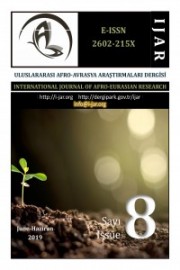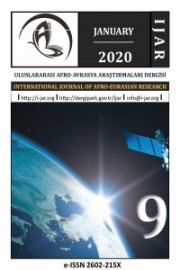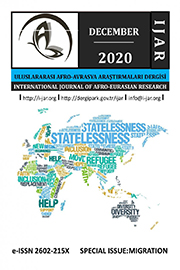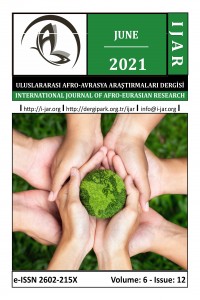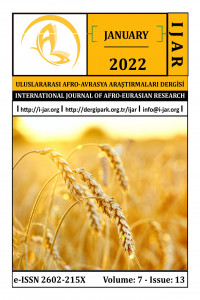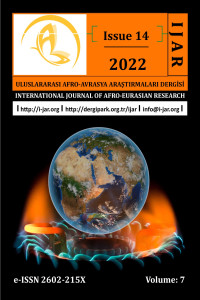GUIDE FOR AUTHORS
- The INTERNATIONAL JOURNAL OF AFRO-EURASIAN RESEARCH is an international peer reviewed journal and publish twoo times in a year in January and June .
- Scientific and original articles which have directly or indirectly relation with economics, business administration, public administration, public finance, econometrics, labor economics, law and politics,economics, finance, history, sociology, philosophy, archeology, art history, international relations, social policy and labor relations, behavioral sciences, linguistics, literature, communications and fine arts can be sent to the Journal.
- The articles sent to the Journal should not be published in any other source or should not be offered to be published.
- Articles should be written in Turkish or English.
- Papers should be prepared in accordance with our rules of spelling, and should be registered to the server. After registration, papers should be uplaoded to the system inclueded the bibliography
- Having too many spelling errors and failure to comply with the requirement of a scientific article will be sufficient for reversal.
- Articles submitted for publication are initially evaluated by our Editorial Commission. Then they are sent to at least two referees to be examined in terms of content and form. Referees’ identities are not released to the authors and the authors are also not informed who the referees for their papers are. ( Double-blinded Rewiew)
- In accordance with the evaluation reports from the referees, the possibilities of the outcome includes accepting & publishing the article, correction, or rejection.
- The opinions in the articles published in the Journal are not the opinions of the Journal. All responsibility belongs to the author.
- All rights of the articles published in the Journal are reserved and cannot be copied without the name of the Journal.
- The Copyright fee is not paid in cash to the author of the article published in the Journal.
- The articles which do not meet the publication principles will not be taken into the peer review process.
For the articles to be sent to The International Journal of Afro-Eurasian Research (IJAR), the authors are required to adhere to the following principles and rules.
The articles which are not prepared in accordance with the principles and rules stated above may not be taken in assessment process, or may be excluded from assessment at any stage of this process.
Spelling Rules
- Papers should be prepared with “Office Word” program and A4 format.
- The length of the paper should not exceed 25 pages in journal format.
- Page layout should be left: 2 cm, right: 2 cm, up: 2 cm, and bottom: 2 cm.
- Articles should be written with font type of "Times New Roman", in 12 font size and with "single" spacing. There should be one space after points and commas.
- Paragraphs should be without an initial indent, 6 nk spaces should be left between the paragraphs. No extra blank lines between the paragraps.
- The title should be written in Turkish and English with 14 font size, Turkish and English abstracts should contain no more than 200 words with 11 font size, and include 3 to 5 key words in Turkish and English.
- The name, surname, and title of the author(s) should be written with 12 font size, under the title and right aligned. The name of institution and e-mail address of the author(s) should be written with font size 10 in the footnote.
- Please add from two or three JEL codes under keywords.
- The headings and subheadings should be appeared in 12 font size, bold and left justified (unindented) and also numbered as 1. 1.1., 1.1.1., 1.1.2., 1.1.2.1. The headings should be capitalized and subheadings should appear in lower case (initial word capitalized). The headings should be partitioned no more than 4 levels. There should be one blank line before the subheadings; no blank line should be given after the subheadings. There should be no blank line before and after the subheadings.
- All the tables, figures and graphics in the paper should be cited in numerical order and center aligned. Each table, figures, and graphics should be given a title. Table title should be placed above the table, figure, and graphic, with 10 pt, centered aligned, and only initial letters capitalized. Table, figure and graphic text should be no smaller than 9 pt and no larger than 11 pt. All tables, figures, and graphics should be clear and can be easily readable and also compatible with the page layout.
- References should be made with conjunction method inside the text. Explanation notes should be under
the page as footnote with 10 pt. References inside the text should be like surname of the author(s),
year of the source, and page number. If there isn’t the name of the author then institution name
should be given instead of author’s name.
Example:
Works by a single author: (Arıdemir, 2017:70)
Works by two authors: (Arıdemir ve Gökçe, 2016:22)
Works by multiple authors: (Arıdemir vd., 2016:35).
Citing more than one sources: (Derjaj, 1948:96; Sayılov, 2015:69)
Citing the whole source: (Drucker, 1995)
Citing the publications without the name of the author: (TÜİK, 2016:45) - If the reference is taken from a web site and the author is known, reference should be made like
periodic publications. If the date of the downloaded source is not given, access date should be
used. If the date of the downloaded source is not given, date of access should be used. Also if no
publisher name is available, use the name of website and data of access.
For example;
If the author’s name and publication year is known: (Elif, 2012)
If the author’s name and publication year is not known:(SPK, 2017) - If you are citing more than one work by the same author in the same year, put the letters a, b, c
next to the year.
Example;
Arıdemir (2016a), Arıdemir (2016b). - All the sources that are cited in the text must appear in the reference page .All sources used in
the text should be ordered alphabetically by author last name. Order the works from the same author
by publication date (Newest to oldest). Bibliography itendentaion should be set (Pendent – 1 cm).
The reference page should be prepared according to example shown below:
- Books
EROL, E. (2008). Stratejik Yönetim ve İşletme Politikası, Beta Basım Yayım, İstanbul.
ACAR, D. and TETİK, N. (2008). Genel Muhasebe, Detay Yayıncılık, Ankara.
DEMİR, Y., ÖZDEMİR, O. and EREN, İ. (2008). Küçük ve Orta Ölçekli İşletmelerde Finansal Yönetim Uygulamaları, Asil Yayın, Ankara.
- Translated Books
DRUCKER, P. (1994). Kapitalist Ötesi Toplum, (Çev.) ÇORAKÇI, B., İnkilap Kitabevi, İstanbul.
- Edited Books
OKÇU, M., AKTEL, M. and KERMAN, U. (2007). “İki Süreci Anlamak: Kamu Yönetiminde Küreselleşme ve 'Avrupalılaşma'”, (Ed.) YILMAZ, A. and BOZKURT, Y., Küresel Esintiler ve Yerel Etkiler Sarmalında Türk Kamu Yönetimi, Gazi Kitabevi, Ankara.
- Book with no Author
DPT (2003). İllerin ve Bölgelerin Sosyo-Ekonomik Gelişmişlik Sıralaması Araştırması (2003), Yayın No: DPT 2671, Ankara.
- Journals
YAVUZ, A., ALBENİ, M. and KAYA, D.G. (2009). “Ulusal İnovasyon Politikaları ve Kamu Harcamaları: Çeşitli Ülkeler Üzerine Bir Karşılaştırma”, Süleyman Demirel Üniversitesi İktisadi ve İdari Bilimler Fakültesi Dergisi, 14(4): 65-90.
- Newspapers
GÖKÇE, D. (1997). “Merkez Bankasının Bağımsızlığı Sorunu”, Milliyet, 15 Mart.
- Theses
ÖZKUL, G. (2008). Girişimcilik Teorileri ve Girişimci Tipleri: Antalya-Burdur-Isparta İllerinde (İBBS Düzey 2 TR61 Bölgesinde) İmalat Sanayi KOBİ'lerindeki Girişimciler Üzerine Bir İnceleme, Yüksek Lisans Tezi, Süleyman Demirel Üniversitesi Sosyal Bilimler Enstitüsü, Isparta.
- Internet Based Sources
(iii) If the authors of the sources are known, it should be given like periodic publications. In addition to this, the web address of the source should be given. If the date of the source is not known, then date of access should be given both in the text and the reference page.Example;
ENER, N. (2002). “Yeni Yükselen Pazarlar (Emerging Markets) İçin Pazarlama Stratejileri”, http://iktisat.uludag.edu.tr/dergi/11/02-neriman/02-neriman.htm, 10.05.2005.
(iv) If the source belongs to an institution instead of an author, there should be the name of the institution, the title of the source and complete web address in the bibliography. Example:
REKABET KURUMU (2010). “Rekabet Hukukunun Esasları”, http://www.rekabet.gov.tr/index.php?Sayfa=sayfaicerik&icId=53, 17.03.2010. - For the cases not mentioned in spelling, scientific publication rules will be taken into consideration.
International Journal of Afro-Eurasian Research (IJAR) ,provide an open access for its contents by believing it will increase the share of knowledge all around the world.
The Evaluation Process of the articles submitted to the journal is as follows:
- The submitted articles are evaluated by the editor and / or members of the editorial board in terms of purpose, scope, method and writing principles (at the same time with plagiarism software). Two referees are appointed by journal editors to evaluate the paper just after the pre-check phase.
- Accepted papers which are appropriate to the principals of publication and writing rules, are sent to two judges, recognized by their work and research area, without specifying the author's name.
- In general, there is a time for the referee to accept the refereeing duty within a period of 15 days. The referee who accepts the duty will be given 30 days to evaluate the paper. Besides this general case, uploading the paper to the system would expedite the process of evaluating.
- When two referees report that the paper is “Not Appropriate for Publishing”, the article is not published in the journal.
- If one of the referees has a positive opinion about the publication of the while the other referee has a negative opinion, the article will be sent to the third referee; The publication’s sequel depends on the third referee’s report.
- Whether the papers are published or not, they are non-returnable. The authors are required to consider the criticism and recommendations of the referees regarding the article they submit if they are asked to correct it.
- The author is responsible for delivering the corrected text within the specified time. The revised text may be reviewed again by the referees in case of need. Neither referees’ nor authors’ identities are shared with each other (Blind Review). Referee reports are archived to be kept.
International Journal of Afro-Eurasian Research (IJAR) does NOT charge publication/processing fees from the Author(s).
All articles sent to our journal will be scanned via Ithenticate, Turnitin or Urkund to get a similarity report before the article goes for review. The upper bound is determined as 15 percent.
If similarity report shows more than 15%, then the article:
- Could be sent back to author(s) to be edited,
- Could be rejected by the editor, or
- Could send to editorial board for evaluation.










.png)
.png)
.png)
.png)
.png)
.png)
.png)
.png)
.png)
.png)
.png)
.png)
